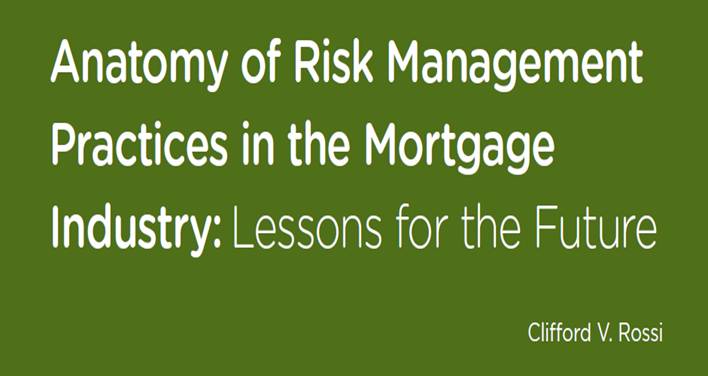Anatomy of Risk Management
Practices in the Mortgage Industry:
Lessons for the Future
Clifford V. Rossi
Robert H. Smith School of Business
University of Maryland
May 2010
Executive Summary
Not since the Great Depression has there been a contraction in the U.S. housing market of such scale. With much attention given already to complex mortgage securities, their risks and impacts on financial markets, this study examines the underlying loan manufacturing process that greatly contributed to excessive risk building across portfolios and mortgage securities alike. Particular attention is focused on the dynamics behind risk taking within mortgage firms leading up to the collapse in housing in order to understand what drove these firms to the brink and what lessons can be learned.
No single factor was responsible for the significant expansion of credit and mortgage products during the period leading up to the mortgage crisis. However, there are indications that greater risk-taking could be attributed to the following factors:
• An over-reliance on performance metrics not adjusted for risk which would lead management
toward riskier products
• Data and analytical limitations and blind spots that led risk managers to grossly underestimate credit losses
• Cognitive biases among senior business managers that over time led them to take greater risks, and in the process reduced the effectiveness of risk management practices
• Incentive problems leading to regulatory actions that wound up not being in the best interest of the taxpayer.
Some of the questions the study seeks to answer include:
• How did the proliferation of mortgage products such as option ARMs come about so quickly?
• How did risk layering factor into decisions to originate, hold and sell mortgage products?
• What were the competitive forces weighing on mortgage originators and how did the governance process work in some institutions and not in others?
• What were the market forces underlying risk decisions and how did early warning systems and leading indicators woefully underestimate risk in such a significant way?
• What explains some of the regulatory responses to firm risk taking during this period?
Why did so many mortgage companies fail? These companies did not abandon standard economic conventions such as profit maximization. Many mortgage specialists sought to improve their attractiveness to investors by seeking growth opportunities. With a sustained period of strong home prices and low credit losses serving as a backdrop to business strategy, cognitive biases allowed senior managers to build up a false sense of security by expanding into a variety of new and ultimately riskier products. Armed with toolkits that did not appropriately differentiate between mortgage product risks, and with estimates of losses that appeared to be within reason, management teams were confident that expanding the credit risk envelope by relaxing underwriting standards across a broad spectrum of mortgage products was in the best interest of shareholders.
Through portfolio simulation analysis, this study demonstrates how greater risk taking could occur. Optimal mortgage investment decisions based on return on equity (ROE) rather than risk-adjusted return on capital (RaRoC) metrics are shown to lead to very different outcomes, due to ROE measures tending to support higher levels of riskier assets. Further, the simulation results shed light on how management biases noted earlier can greatly limit the effectiveness of standard risk management practices such as concentration limits and reinsurance.
One of the study’s original contributions reaches across the field of behavioral economics to explain risk management decisions leading up to the crisis. Short-term incentive structures may have contributed to poor risk decisions, however, a variety of cognitive biases may also have contributed by lowering management loss aversion, encouraging management to follow competitors into riskier products and discounting the information and stature of risk management teams.
A number of important lessons for the mortgage industry, regulators and investors emerge from the study. These include the need for a comprehensive focus on development of industry-wide data and techniques for measuring risk; implementation of risk-adjusted return measures for firm objectivesetting; individual performance assessment; and greater introspection on the part of management teams to validate external information against a stated risk vision.
Full report below…
4closureFraud
Anatomy of Risk Management Practices in the Mortgage Industry: Lessons for the Future


Are you kidding me?
Homeowners took down the system? This guy doesn’t have a clue.
Wall Street and GREED took down the system. They threw out all the rules and did whatever they wanted to find someone to fog a mirror.